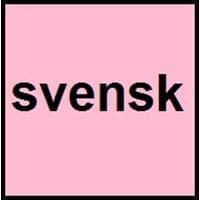Irish vs Swedish
Countries
European Union, Ireland
European Union, Finland, Nordic Council, Sweden
National Language
Ireland
Sweden
Second Language
Ireland
Finland
Speaking Continents
Europe
Antartica, Europe
Minority Language
United Kingdom
Australia, Belgium, Canada, France, Germany, Netherlands, Spain, Switzerland, United Kingdom, United States of America
Regulated By
Foras na Gaeilge
Institute for the Languages of Finland, Swedish Academy, Swedish Language Council
Interesting Facts
- In Irish language, there are no exact words for "yes" or "no".
- There are different set of numbers for counting humans and another set for counting non-humans in Irish Language.
- In Swedish language, article comes after noun.
- Most of the words in Swedish language began "S" than any other letter.
Similar To
Not Available
Norwegian and Danish Language
Derived From
Not Available
Old Norse Language
Alphabets in
Irish-Alphabets.jpg#200
Swedish-Aphabets.jpg#200
Writing Direction
Left-To-Right, Horizontal
Left-To-Right, Horizontal
Thank You
Go raibh maith agat
tacka dig
How Are You?
Conas atá tú ?
hur mår du
Good Night
Oíche mhaith
godnatt
Good Evening
Tráthnóna maith duit
god kväll
Good Afternoon
Tráthnóna maith duit
god eftermiddag
Good Morning
Dia dhuit ar maidin
god morgon
Please
le do thoil
vänligen
I Love You
Is breá liom thú
jag älskar dig
Excuse Me
Gabh mo leithscéal
ursäkta mig
Dialect 1
Connacht Irish
Dialects
Where They Speak
Connacht
Gabon
How Many People Speak
Not Available
Dialect 2
Munster Irish
Dialects
Where They Speak
Munster
Georgia
How Many People Speak
Not Available
Dialect 3
Ulster Irish
Dialects
Where They Speak
Ulster
France
How Many People Speak
Not Available
Speaking Population
Not Available
Native Name
Gaeilge (na hÉireann) / An Ghaeilge
Svenska
Alternative Names
Erse, Gaeilge, Gaelic Irish
Ruotsi, Svenska
French Name
irlandais moyen
suédois
German Name
Mittelirisch
Schwedisch
Pronunciation
[ˈɡeːlʲɟə]
[ˈsvɛ̂nskâ]
Ethnicity
Irish people
Swedes, Finland Swedes
Origin
c. 750
13th Century
Language Family
Indo-European Family
Indo-European Family
Branch
Goidelic
Northern (Scandinavian)
Early Forms
Primitive Irish, Old Irish, Middle Irish, Classical Irish, Irish
Old Swedish
Standard Forms
An Caighdeán Oifigiúil
Standard Swedish
Language Position
Not Available
Signed Forms
Irish Sign Language
Tecknad svenska, ("Signed Swedish")
Scope
Individual
Individual
ISO 639 6
Not Available
Not Available
Glottocode
iris1253
swed1254
Linguasphere
50-AAA
52-AAA-ck to -cw
Language Type
Living
Living
Language Linguistic Typology
Verb-Subject-Object
Subject-Verb-Object
Language Morphological Typology
Fusional
Not Available
Irish and Swedish Language History
Comparison of Irish vs Swedish language history gives us differences between origin of Irish and Swedish language. History of Irish language states that this language originated in c. 750 whereas history of Swedish language states that this language originated in 13th Century. Family of the language also forms a part of history of that language. More on language families of these languages can be found out on Irish and Swedish Language History.
Irish and Swedish Greetings
People around the world use different languages to interact with each other. Even if we cannot communicate fluently in any language, it will always be beneficial to know about some of the common greetings or phrases from that language. This is where Irish and Swedish greetings helps you to understand basic phrases in Irish and Swedish language. Irish word for "Hello" is Dia dhuit or Swedish word for "Thank You" is tacka dig. Find more of such common Irish Greetings and Swedish Greetings. These greetings will help you to be more confident when conversing with natives that speak these languages.
Irish vs Swedish Difficulty
The Irish vs Swedish difficulty level basically depends on the number of Irish Alphabets and Swedish Alphabets. Also the number of vowels and consonants in the language plays an important role in deciding the difficulty level of that language. The important points to be considered when we compare Irish and Swedish are the origin, speaking countries, language family, different greetings, speaking population of these languages. Want to know in Irish and Swedish, which language is harder to learn? Time required to learn Irish is 36 weeks while to learn Swedish time required is 24 weeks.





